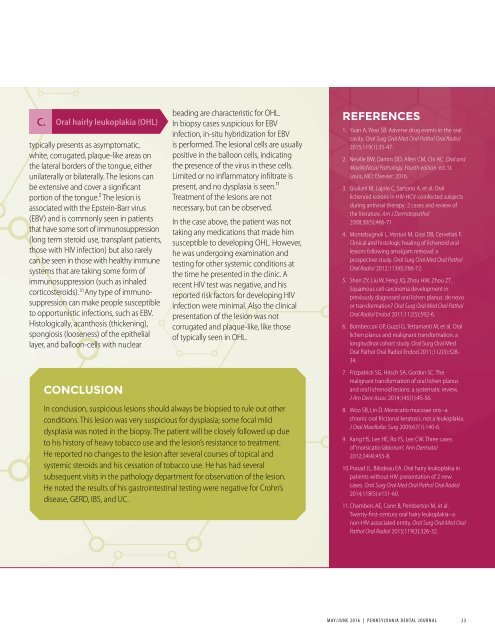MAY/JUNE
1TvnmH5
1TvnmH5
Create successful ePaper yourself
Turn your PDF publications into a flip-book with our unique Google optimized e-Paper software.
C. Oral hairly leukoplakia (OHL)<br />
typically presents as asymptomatic,<br />
white, corrugated, plaque-like areas on<br />
the lateral borders of the tongue, either<br />
unilaterally or bilaterally. The lesions can<br />
be extensive and cover a significant<br />
portion of the tongue.2 The lesion is<br />
associated with the Epstein-Barr virus<br />
(EBV) and is commonly seen in patients<br />
that have some sort of immunosuppression<br />
(long term steroid use, transplant patients,<br />
those with HIV infection) but also rarely<br />
can be seen in those with healthy immune<br />
systems that are taking some form of<br />
immunosuppression (such as inhaled<br />
corticosteroids). 10 Any type of immunosuppression<br />
can make people susceptible<br />
to opportunistic infections, such as EBV.<br />
Histologically, acanthosis (thickening),<br />
spongiosis (looseness) of the epithelial<br />
layer, and balloon-cells with nuclear<br />
CONCLUSION<br />
beading are characteristic for OHL.<br />
In biopsy cases suspicious for EBV<br />
infection, in-situ hybridization for EBV<br />
is performed. The lesional cells are usually<br />
positive in the balloon cells, indicating<br />
the presence of the virus in these cells.<br />
Limited or no inflammatory infiltrate is<br />
present, and no dysplasia is seen.11<br />
Treatment of the lesions are not<br />
necessary, but can be observed.<br />
In the case above, the patient was not<br />
taking any medications that made him<br />
susceptible to developing OHL. However,<br />
he was undergoing examination and<br />
testing for other systemic conditions at<br />
the time he presented in the clinic. A<br />
recent HIV test was negative, and his<br />
reported risk factors for developing HIV<br />
infection were minimal. Also the clinical<br />
presentation of the lesion was not<br />
corrugated and plaque-like, like those<br />
of typically seen in OHL.<br />
In conclusion, suspicious lesions should always be biopsied to rule out other<br />
conditions. This lesion was very suspicious for dysplasia; some focal mild<br />
dysplasia was noted in the biopsy. The patient will be closely followed up due<br />
to his history of heavy tobacco use and the lesion’s resistance to treatment.<br />
He reported no changes to the lesion after several courses of topical and<br />
systemic steroids and his cessation of tobacco use. He has had several<br />
subsequent visits in the pathology department for observation of the lesion.<br />
He noted the results of his gastrointestinal testing were negative for Crohn’s<br />
disease, GERD, IBS, and UC.<br />
REFERENCES<br />
1. Yuan A, Woo SB. Adverse drug events in the oral<br />
cavity. Oral Surg Oral Med Oral Pathol Oral Radiol<br />
2015;119(1):35-47.<br />
2. Neville BW, Damm DD, Allen CM, Chi AC. Oral and<br />
Maxillofacial Pathology. Fourth edition. ed. St.<br />
Louis, MO: Elsevier; 2016.<br />
3. Giuliani M, Lajolo C, Sartorio A, et al. Oral<br />
lichenoid lesions in HIV-HCV-coinfected subjects<br />
during antiviral therapy: 2 cases and review of<br />
the literature. Am J Dermatopathol<br />
2008;30(5):466-71.<br />
4. Montebugnoli L, Venturi M, Gissi DB, Cervellati F.<br />
Clinical and histologic healing of lichenoid oral<br />
lesions following amalgam removal: a<br />
prospective study. Oral Surg Oral Med Oral Pathol<br />
Oral Radiol 2012;113(6):766-72.<br />
5. Shen ZY, Liu W, Feng JQ, Zhou HW, Zhou ZT.<br />
Squamous cell carcinoma development in<br />
previously diagnosed oral lichen planus: de novo<br />
or transformation? Oral Surg Oral Med Oral Pathol<br />
Oral Radiol Endod 2011;112(5):592-6.<br />
6. Bombeccari GP, Guzzi G, Tettamanti M, et al. Oral<br />
lichen planus and malignant transformation: a<br />
longitudinal cohort study. Oral Surg Oral Med<br />
Oral Pathol Oral Radiol Endod 2011;112(3):328-<br />
34.<br />
7. Fitzpatrick SG, Hirsch SA, Gordon SC. The<br />
malignant transformation of oral lichen planus<br />
and oral lichenoid lesions: a systematic review.<br />
J Am Dent Assoc 2014;145(1):45-56.<br />
8. Woo SB, Lin D. Morsicatio mucosae oris--a<br />
chronic oral frictional keratosis, not a leukoplakia.<br />
J Oral Maxillofac Surg 2009;67(1):140-6.<br />
9. Kang HS, Lee HE, Ro YS, Lee CW. Three cases<br />
of ‘morsicatio labiorum’. Ann Dermatol<br />
2012;24(4):455-8.<br />
10. Prasad JL, Bilodeau EA. Oral hairy leukoplakia in<br />
patients without HIV: presentation of 2 new<br />
cases. Oral Surg Oral Med Oral Pathol Oral Radiol<br />
2014;118(5):e151-60.<br />
11. Chambers AE, Conn B, Pemberton M, et al.<br />
Twenty-first-century oral hairy leukoplakia--a<br />
non-HIV-associated entity. Oral Surg Oral Med Oral<br />
Pathol Oral Radiol 2015;119(3):326-32.<br />
<strong>MAY</strong>/<strong>JUNE</strong> 2016 | PENNSYLVANIA DENTAL JOURNAL 23


